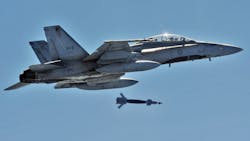Marvin to build missile launchers and bomb-ejector racks for Navy combat jets in $132.5 million deal
PATUXENT RIVER NAS, Md. – U.S. Navy aerial warfare experts are ordering special new missile launchers and bomb-ejector racks to enable Navy F/A-18 Hornet jet fighter-bombers to carry the nation's latest and most lethal air-to-air missiles and smart munitions.
Officials of the Naval Air Systems Command at Patuxent River Naval Air Station, Md. announced a $132.5 million contract Tuesday to Marvin Engineering Co. Inc. in Inglewood, Calif., to build as many as 1,339 BRU-32B/A bomb-ejector racks and as many as 1,056 LAU-127E/A guided missile launchers for the Navy the F/A-18E/F and EA-18G fighter-bomber and electronic warfare (EW) carrier-based jets.
The BRU-32B/A is the successor to the earlier BRU-32A/A, the latter of which is integrated on early-model F/A-18A/B/C/D Hornet jet fighter-bomber aircraft.
These systems are heavy-duty dual-piston pyrotechnic bomb-ejector racks to carry and release bombs, smart weapons, and other munitions that weight as much as 4,200 pounds. It features automatic store sway bracing and allows for 14- or 30-inch suspension from underneath the aircraft's wings. The BRU-32B/A is 37 inches long, 7.3 inches wide, 7.5 inches high, and weighs 76 pounds.
The Marvin LAU-127 missile rail launcher, meanwhile, enables the F/A-18 carrier-based strike fighter to carry and launch the radar-guided AIM-120 Advanced Medium-Range Air-to-Air Missile (AMRAAM) and the AIM-9X Sidewinder heat-seeking missile.
This contract involves LAU-127E/A, which has a slight weight variation from the Marvin LAU-127A/A, LAU-127B/A, LAU-127C/A, LAU-127D/A, and LAU-127F/A versions.
The LAU-127 provides the electrical and mechanical interface between the AMRAAM and AIM-9X air-to-air missile systems and F/A-18 combat jets, as well as the two-way data transfer between the missile and the aircraft's cockpit controls and displays.
The electrical interfaces between the LAU-127 and the F/A-18 air crew also supports preflight orientation and control circuits to prepare and launch the missiles.
The Marvin LAU-127 is part of a family of single-rail missile launchers that fire AIM-9 Sidewinder of AIM-120 AMRAAM missiles from under-wing stations of the aircraft, mounted to pylons, or on wingtip stations.
The LAU-127E/A is integrated with F/A-18A/B/C/D Hornets, F/A-18E/F Super Hornets and EA-18 Growlers. It contains a power supply and a supply of bottled nitrogen coolant for the missile seeker heads. The missile launcher is nearly nine fee long, 3.6 inches wide, and 6 inches high, and weighs 87 pounds.
The Raytheon AMRAAM is an advanced radar-guided missile developed to replace the AIM-7 Sparrow missile. It provides multi-shot capability, and can be launched day or night, in all weather conditions. Its autonomous guidance capability provides the pilot with launch-and-leave ability to provide fast engagement of follow-on targets or the option to fire first and then run from targets.
The Raytheon AIM-9X is a relatively short-range infrared heat-seeking missile that equips most jet fighters, fighter-bombers, and other offensive combat aircraft in the U.S. arsenal, and is used to shoot down enemy aircraft close by. The AIM-9X works by homing in on an enemy aircraft's hot engine exhaust. Variants of the AIM-9 Sidewinder have been deployed since the 1950s.
On this contract Marvin Engineering will do the work in Inglewood, Calif., and should be finished by September 2027. For more information contact Marvin Engineering online at http://marvineng.com, or Naval Air Systems Command at www.navair.navy.mil.
About the Author
John Keller
Editor-in-Chief
John Keller is the Editor-in-Chief, Military & Aerospace Electronics Magazine--provides extensive coverage and analysis of enabling electronics and optoelectronic technologies in military, space and commercial aviation applications. John has been a member of the Military & Aerospace Electronics staff since 1989 and chief editor since 1995.
